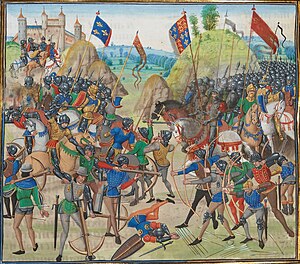Busur panjang Inggris
Busur panjang Inggris, disebut juga busur panjang Wales, adalah jenis busur panjang Abad Pertengahan yang kuat yang banyak digunakan oleh orang Inggris dan orang Wales untuk berburu dan sebagai senjata dalam peperangan Abad Pertengahan. Pengunaan busur panah ini oleh Inggris ternyata efektif melawan Perancis pada saat Perang Seratus Tahun, tepatnya saat dimulainya perang dalam pertempuran Sluys (1340), Crécy (1346), dan Poitiers (1356); Dan mungkin yang paling terkenal adalah Pertemppuran Agincourt (1415). Mereka mulai tidak efektif lagi setelah gugurnya pemanah panjang di Pertempuran Verneuil (1424), dan menjadi benar-benar kelabakan di Pertempuran Patay (1429) saat mereka maju sebelum mengatur posisi bertahan. Istilah busur panah panjang "Inggris" atau "Welsh" dalam penggunaan modern untuk membedakan panah busur ini dari busur panah panjang lainnya, walaupan pada kenyataannya busur panah yang sama digunakan di wilayah utara dan timur Eropa; meskipun sebagian besar ide busur ini berasal dari Spanyol sekitar abad ke-14.[butuh rujukan]


Busur panjang Inggris tertua ditemukan di padang rumput Ashcott, Somerset, yang diperkirakan dari tahun 2665 SM,[1] tapi tak ada busur panjang yang ditemukan dari masa kejayaan busur panah panjang (sekitar 1250–1450 Masehi),[2] kemungkinan karena busurnya usang, rusak dan digantikan secara berkala, bukannya diwariskan dari generasi ke generasi.[3] Bagaimanapun, lebih dari 130 busur ditemukan pada masa Renaissans. Lebih dari 3,500 panah dan 137 penh panjang diekskavasi dari Mary Rose, kapal Henry VIII yang karam di Portsmouth tahun 1545.
Catatan kaki
- ^ Bacon 1971, hlm. 16
- ^ Kaiser 1980
- ^ Levick 1992
Referensi
- Buku
- Andrzejewski, Stanislaw (2003) [1954]. Military organization and society. ISBN 978-0-415-17680-4.
- Auden, Thomas (2008). Memorials of Old Shropshire. Read Books. ISBN 1-4097-6478-8.
- Bacon, Edward (1971). Archaeology: Discoveries in the 1960s. New York: Praeger. ISBN 0-304-93635-9.
- Bradbury, Jim (1985). The Medieval Archer. The Boydell Press. ISBN 0-85115-194-9.
- Barker, Juliet (2006). Agincourt: Henry V and the Battle That Made England. Little, Brown and Co. ISBN 0-316-01503-2.
- Conan Doyle, Arthur (1 May 1997). The White Company. Project Gutenberg.
- Featherstone, Donald (1973) [1967]. Bowmen of England. London: New English Library. ISBN 9780450016264.
- Hageneder, F. (2007). Yew: A History. Sutton Publishing. ISBN 978-0-7509-4597-4.
- Heath, E.G. (1980). Archery : A Military History. London: Osprey. ISBN 0850453534.
- Heath, E.G. (??) [1972]. The Grey Goose Wing. hlm. 134.
- Kruschke, Earl Roger (1985). The right to keep and bear arms: a continuing American dilemma. C.C. Thomas Publishing Co. ISBN 0-398-05141-0.
- Longman, C.J.; Walrond, H. (1967). Archery. New York: Fiederick Ungar Publishing Co.
- Oakeshott, R. Ewart (1960). The Archaeology of Weapons. London: Lutterworth Press.
- Pope, Saxton (2003). Hunting with the Bow and Arrow. Project Gutenberg EBook.
- Rothero, Christopher (1984). The Scottish and Welsh wars, 1250–1400. Men at Arms. London: Osprey. ISBN 0-85045-542-1.
- Sellman, Roger (1964). Mediaeval English Warfare. London: Methuen. ISBN 978-0-416-63620-8.
- Strickland, Matthew; Hardy, Robert (2005). The Great Warbow: From Hastings to the Mary Rose. Sutton Publishing. ISBN 0-7509-3167-1.
- Trevelyan, G. M. (2008). English Social History – A Survey of Six Centuries – Chaucer to Queen Victoria. READ BOOKS. ISBN 978-1-4437-2095-3.
- Jurnal
- Cummins, Josephine (November 2006). "Saving Prince Hal: maxillo-facial surgery, 1403" (PDF). Dental History Magazine. Glasgow, Scotland: History of Dentistry Research Group, University of Glasgow (19). ISSN 1756-1728. Diakses tanggal 19 August 2012.
- Kaiser, Robert E. (December 2003). "Medieval Military Surgery". Medieval History Magazine. 1 (4).
- Kaiser, Robert E. (1980). "The Medieval English Longbow". Journal of the Society of Archer-Antiquaries. 23.
- Rogers, Clifford J. (2011). "The development of the longbow in late medieval England and "technological determinism"". Journal of Medieval History. 37 (3).
- Other
- Levick, Ben (1992). "They Didn't Have Bows, Did They?". Regia Anglorum Publications 2002. Hapus pranala luar di parameter
|publisher=(bantuan)
Bacaan lanjutan
- Buku
- Allely, Steve (2000) [1992], Hamm, Jim, ed., The Traditional Bowyers Bible, 1, The Lyons Press, ISBN 1-59921-453-9
- Aspel, G. Fred (2000) [1993], Hamm, Jim, ed., The Traditional Bowyers Bible, 2, The Lyons Press, ISBN 1-58574-086-1
- Baker, Tim (2000) [1994], Hamm, Jim, ed., The Traditional Bowyers Bible, 3, The Lyons Press, ISBN 1-58574-087-X
- Allely, Steve (2008), Hamm, Jim, ed., The Traditional Bowyers Bible, 4, The Lyons Press, ISBN 978-1-59921-453-5
- Hardy, Robert (1992), Longbow: A Social and Military History, Patrick Stephens, ISBN 1-85260-412-3
- Soar, Hugh David Hewitt (2004), The Crooked Stick: A History of the Longbow (Weapons in History S.), Westholme U.S., ISBN 1-59416-002-3
- Jurnal
- Thomas Esper The Replacement of the Longbow by Firearms in the English Army, Technology and Culture, Vol. VI, No. 3, 1965.
- B.W. Kooi C.A. Bergman. PDF:An Approach to the Study of Ancient Archery using Mathematical Modelling, Antiquity 71:(271) 124–134 (1979)
- Lainnya
- Rulon l. Hancock. PDF: United States National Archery Association Flight committee modern longbow flight rules, U.S. National Archery Association. September 2002.
- Paul Lalonde. A Bundle of Tudor War Arrows, An article about the arrows found on the Mary Rose.
- Liesl Wilhelmstochter. Ealdormere Archery Handbook: Section 11: Towards a more medieval archer
- Staff. Mary Rose historical ship, The Mary Rose Trust – {note: BACK of bow faces enemy.}
- The Great Northwood Bowmen Medieval Longbow Archery and re-enactment Society, re-enacting the 15th century, based in London.